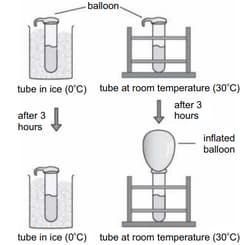NCERT Solutions for Chapter: Microorganisms: Friend and Foe, Exercise 1: Exercise
NCERT Science Solutions for Exercise - NCERT Solutions for Chapter: Microorganisms: Friend and Foe, Exercise 1: Exercise
Attempt the practice questions on Chapter 2: Microorganisms: Friend and Foe, Exercise 1: Exercise with hints and solutions to strengthen your understanding. Science Textbook of Competency Based Questions for Class VIII solutions are prepared by Experienced Embibe Experts.
Questions from NCERT Solutions for Chapter: Microorganisms: Friend and Foe, Exercise 1: Exercise with Hints & Solutions
Manoj adds some yeast to two test tubes containing sugar solution. One test tube is kept in ice and the other at room temperature. The picture shows what happens after three hours.

What is Manoj investigating?
Manoj adds some yeast to two test tubes containing sugar solution. One test tube is kept in ice and the other at room temperature. The picture shows what happens after three hours.

How can Manoj confirm if the gas produced in the test tube at room temperature was due to the yeast growing in it?
Manoj adds some yeast to two test tubes containing sugar solution. One test tube is kept in ice and the other at room temperature. The picture shows what happens after three hours.

What should Manoj keep the same in both the test tubes for a fair experiment?
What type of organism is yeast?
How do plants take up nitrogen?
Plants and animals are continuously using nitrogen. Will there be a depletion of nitrogen in the environment due to this continuous use? Explain your answer.
Identify the wrong statement.
A. A vaccine is a biological preparation that contains active or weakened microbe.
B. Polio is an infectious disease caused by bacteria.
C. Cancer is caused due to abnormalities in DNA.
D. Lifestyle habits can cause diseases like obesity.
Distinguish between photosynthetic bacteria and chemosythetic bacteria.
